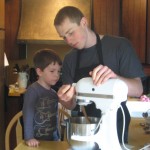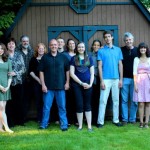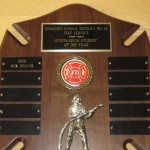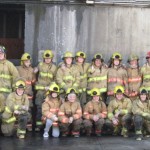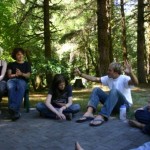
During a discussion on the Living Math Forum email list, people were talking about how kids can learn mathematical skills in their own way, without necessarily relying on textbooks and formal study. Here’s a post I sent, sharing an example of some problem solving Ben and I enjoyed when he was about 10.
While playing with some one-inch square color tiles, we decided to estimate the surface area of our living room coffee table. (I have color tiles on hand because they’re fun to make patterns with, and they lend themselves well to illustrating multiplication concepts like this.)
We covered the table with color tiles and then figured the area by multiplying rectangular sections of the table. One of the rectangular sections was 23 x 14. Instead of figuring 23 x 14 with a standard multiplication method on paper, he broke the numbers apart in his own way and was able to do all of it in his head. He much prefers this method.
He started by multiplying 23 x 10 = 230. Then he needed 23 x 4, but instead of that he figured 23 x 5 (because it was easier to just figure 1/2 of his first answer, or 115). He then added those numbers (230 + 115 = 345) and then subtracted one 23 to get the total answer of 322.
He doesn’t usually explain all of his thinking while he’s doing it, but I often ask him to when he’s finished. Then sometimes I’ll write it down so I can remember what he did. Here’s what it looked like when I wrote it down later: 23 x 14 = (23 x 10) + (23 x 5) – 23 = 322
I’ve learned a lot from him about thinking about numbers in new ways like this. On one level this might seem harder or take longer, but it’s really quite easy when you start to pull apart the numbers and think about what they mean and how they relate to each other. I think a couple problems thought through like this are more valuable than a couple dozen written problems on a workbook page. Lots more fun, too.
Tags: color tiles, mathematics, play, problem solving
Category Square Color Tiles, What Do You Do All Day? |
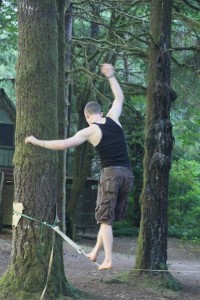 A while back, someone wrote to our local homeschooling group email list and asked the following question:
A while back, someone wrote to our local homeschooling group email list and asked the following question:
“Do you find you miss the hours of “free play” time when you have lots of stuff scheduled? I guess I’m afraid of running out of time for fort-building, hammock swinging, storytelling, bike riding, etc.”
She received many good responses about the need for free play. Here’s what I wrote:
I think these are the most important activities you can allow time for. It’s really easy to over-schedule, and when that happens, we don’t have time to just play. Classes and clubs and field trips are great, but they aren’t any more important than ordinary, everyday play and everyday activities.
My son is 15 now, and I don’t regret any of the time we’ve had simply reading, playing games, building with Lego, exploring nature, baking, and relaxing together.
It’s so easy to want to do everything. It all sounds so enticing. We don’t have to do it all at once. We’ve got years and years. Look at what you like to do together, how busy you like to be within a day or week or month, and find the balance that makes everyone happy. Less is more.
Tags: creating our own path, play, what do you do all day?
Category Adventures, Creating Our Own Path, What Do You Do All Day? |
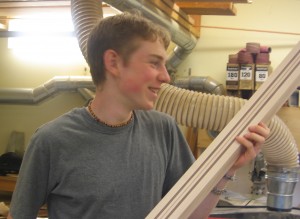 On a trip to the Oregon coast this past summer, when Ben was 16, we enjoyed a spontaneous stop at The Myrtlewood Gallery in Reedsport. It’s part gift shop, part wood shop, and Ben thought they might have some good tonewood lumber there for building guitar bodies. They did. The selection was amazing, and he loved looking at all the different tonewoods, both hard and soft, to consider their potential uses. We stayed there for at least an hour so he could explore the store and all the woods available. There was so much to choose from that we decided to come back the next day so he wouldn’t have to rush his decisions. It was definitely worth another trip in order to have enough time to find just the right pieces for several future guitars.
On a trip to the Oregon coast this past summer, when Ben was 16, we enjoyed a spontaneous stop at The Myrtlewood Gallery in Reedsport. It’s part gift shop, part wood shop, and Ben thought they might have some good tonewood lumber there for building guitar bodies. They did. The selection was amazing, and he loved looking at all the different tonewoods, both hard and soft, to consider their potential uses. We stayed there for at least an hour so he could explore the store and all the woods available. There was so much to choose from that we decided to come back the next day so he wouldn’t have to rush his decisions. It was definitely worth another trip in order to have enough time to find just the right pieces for several future guitars.
While exploring the gallery, I watched Ben envision many exciting uses for the different woods he was finding. He was trying to decide which were the very best pieces and how many he wanted to afford for various projects. We both knew these were good quality woods and prices he wouldn’t be able to find at home. I loved hearing him think out loud about all his choices, and I knew that any of these pieces would give him weeks and months of interesting projects to work on.
Ben didn’t have money with him that first day, but I did. I also told him I was happy to get a little more from a nearby cash machine in case we needed it the next day. At home, he has a savings account with his own money saved for future projects, and he’s quite mindful about how he spends it. He’s always willing to use his own money when something is important to him.
While Ben was contemplating all his options, I let him know that I wanted to buy at least one of the especially pretty pieces for him because I recognized what a great opportunity it was. I wanted to help him with this purchase so he’d have enough money of his own to buy at least a couple more pieces which would allow him many different types of guitar-building projects when we got home.
In the end, Ben found some beautiful pieces of tonewoods for himself and picked out a couple more for his dad as well. I got the benefit of spending time with him and helping him pursue something he loved. We enjoyed good conversations and the excitement that comes with planning new projects. It was definitely time and money well spent.
Tags: adventures, generosity, growing up, projects, what do you do all day?
Category Adventures, Growing Up, Projects, What Do You Do All Day? |
 At age 8, my son was not interested in reading independently. He could read a few easy reader books with help, if I suggested it, but he really wasn’t interested, and much preferred that I read aloud to him instead. He wasn’t ready to read on his own until age 10. Several years later now, he reads a lot – as much as and as well as his friends who were reading much earlier. It just took time for him.
At age 8, my son was not interested in reading independently. He could read a few easy reader books with help, if I suggested it, but he really wasn’t interested, and much preferred that I read aloud to him instead. He wasn’t ready to read on his own until age 10. Several years later now, he reads a lot – as much as and as well as his friends who were reading much earlier. It just took time for him.
A few books and resources that were helpful to me along the way:
Learning at Home: A Mother’s Guide to Homeschooling by Marty Layne – Layne writes about her children’s different processes of learning to read, with a focus on one of her sons who learned to read at age 12.
Growing Without Schooling: A Record of a Grassroots Movement by John Holt – In this book, Holt describes several ideas for helping children read, as well as how one principal supported the emergent reading skills of his students.
Guerrilla Learning: How to Give Your Kids a Real Education With or Without School by Grace Llewellyn and Amy Silver – This book offers encouragement to help us relax about the natural process of learning.
Learning to Read Naturally Accounts of unschoolers and how their reading developed, collected by Sandra Dodd
Tags: creating our own path, good books, reading
Category Books for Parents, Homeschooling Books, Reading |

- A couple years later, at 13, Ben still loves boats!
Ben enjoyed a new reading milestone for himself this month. For years, we cherished Arthur Ransome’s Swallows & Amazons books, always reading them aloud together. They’re full of exciting adventures and wonderful characters. In the past, Ben didn’t want to read them to himself because he was overwhelmed by the small print, lengthy chapters, and complex sentence structure.
For the first time this month, however, at age eleven, Ben has chosen to read one of these books on his own. We had just started reading aloud the 11th book in the series, The Picts & the Martyrs, but after we read the first few chapters together, Ben just kept reading it on his own. He took it to bed for some late night reading, enjoyed it while eating breakfast at the dining room table, and brought it along for reading in the car as well. I’ve read maybe a chapter of it with him during the week, but mostly he’s read it on his own, summarizing the details for me so I can keep up with the storyline.
I love that we have these books to share together, and I love watching Ben’s confidence grow as an independent reader.
Tags: good books, reading
Category Children's Books, Reading |
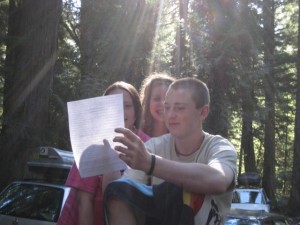
- Reading scavenger hunt directions with friends, age 13
Why is it that we can easily understand that toddlers will learn to walk and talk at different ages, in varying ways, yet people still expect that all children will learn to read within the same timetable?
If a toddler isn’t walking much by 12 months of age, people just smile and say, “Oh, look at the way he’s crawling, or pulling himself up, or using the coffee table to help him cruise around. He’ll be walking soon.” But with reading, it seems to be an all or nothing proposition. “What do you mean, he’s not reading by age seven? Aren’t you worried?”
Our son was a late-blooming reader. For years, we read other people’s homeschooling stories about how their children learned to read. Some early, some later. They learned in their own ways when they were ready.
During the first ten years of his life, we read aloud to Ben nearly every day and he listened to many stories and songs on CD. He knew the alphabet early on, had a big vocabulary, and loved books and stories of every kind. He could sound out simple words if needed, could read street and restaurant signs, but he wasn’t very interested in independent book-reading during his early years, seemingly overwhelmed by large blocks of text.
So we read wonderful books with interesting characters and engaging plots. From these he learned an amazing amount of vocabulary, complex sentence structure, and the richness of all sorts of amazing stories. Here are a few of our favorites: Winnie the Pooh, Swallows & Amazons, The Last of the Really Great Whangdoodles, Tuck Everlasting, and The BFG
Every now and then, I’d bring out the easy reader books, especially those with interesting, predictable texts. Ben enjoyed some of them and could gradually read them with a little help. A few more favorites: Henry & Mudge, Mr. Putter & Tabby, So Many Bunnies, Mary Wore Her Red Dress, and Green Light Readers
We played with words, sang songs, and enjoyed a few homemade reading games. But Ben didn’t especially care about reading on his own. He mostly enjoyed us reading aloud to him.
Then came Calvin and Hobbes. At first I would read all the comics aloud to him. We laughed. We’d read our favorites again and again – they were interesting enough to keep him engaged and wanting more. Sometimes I would read Calvin’s parts, and Ben would read Hobbes’s parts. The print itself was easy to read and written in small chunks, and he could enjoy a whole storyline in just a few pages. They were so funny, it was easy to just read more and more. So we did.
Gradually, Ben would take these books off by himself to read on his own. He’d come to us if he needed help reading a certain word or phrase, but mostly he’d just figure things out himself. We learned not to make him sound out words when he was stuck, because usually he had tried that already, and that’s why he was asking us. Also, it would just keep him from getting to the good parts, which was what kept him reading.
It wasn’t long before the following books started attracting his attention, and he realized he could read them also: The Magic Tree House Books, Encyclopedia Brown, The Hardy Boys, and Henry & Ribsy
So all this is to say that Ben really became a fluent reader in his own right between the ages of ten and eleven…joyfully, and with confidence and a continuing love for books that will last his entire life.
Give your child time. Have plenty of books around. Read together. Every child’s journey with reading is different. Enjoy the process.
Tags: creating our own path, good books, reading, what do you do all day?
Category Children's Books, Reading, What Do You Do All Day? |









